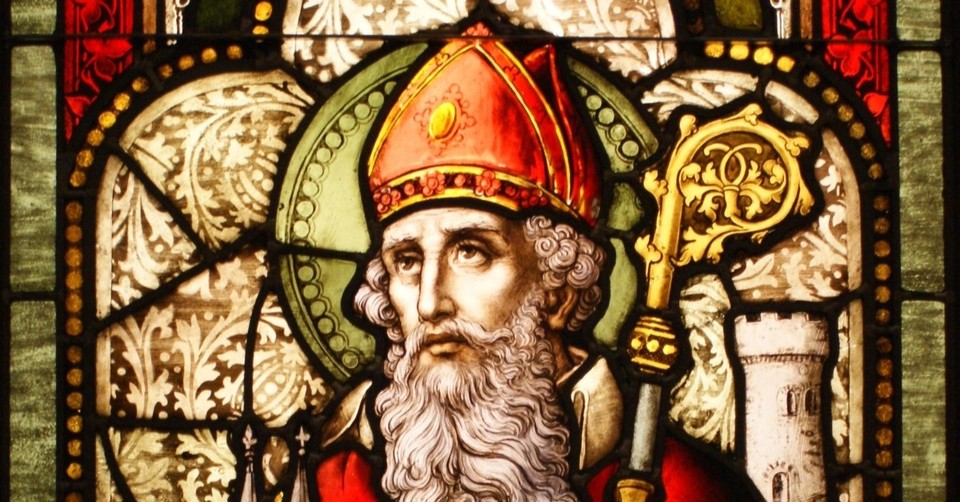Saint Patrick: Practical Theologian, Social Activist

Who Was St. Patrick?
Good question. Most of my knowledge about St. Patrick came from the Veggie Tales' Sumo of the Opera episode, so when asked to write this article, I had some research to do. Sorting out myth-story from history became difficult when studying about someone who lived at the far edge of the civilized world during the decline of the Roman empire, but there were a few facts I discovered about Patricius (Patrick).
Patrick lived after Christianity became mainstream in the Roman Empire. He was born sometime around AD 386 in Britain and died around 460 in Ireland.[1] His grandfather was a priest, and his father was a Roman official who was also a deacon in the Roman church. Patrick left behind two documents: his Confession and Letter to Coroticus.
When I started reading both the legendary and historical material about Patrick, two key characteristics struck me. First, according to legend, Patrick was a practical theologian. Second, according to history, Patrick was a social activist.
Patrick the Practical Theologian
Patrick's story as a bishop to the Irish began oddly: kidnapped by pirates at age 16, he was taken from Britain to Ireland. Sold into slavery, he spent six years as a shepherd. According to Thomas Cahill, he had two constant companions: nakedness and hunger.[2] It was under these harsh conditions that Patrick learned to pray constantly. One night he heard a mysterious voice telling him it was time to leave Ireland, and after walking to a seaport, he miraculously found passage away from Ireland, and eventually, back to Britain.
Because of his captivity, Patrick missed a formal education. He later spent time training for the priesthood, but he lacked the classical training of his contemporaries. As a consequence, when he finally went back to Ireland, he had to rely on skills other than classical oration or philosophical theology to work with the Irish people.
His lack of training became a strength. When he came up against Druidic shaman and pagan kings, it was Patrick's prayer life that impressed them and not his rhetorical skill.
Patrick's belief that all the world belonged to God became part of his power. An example of his confidence in God's world was his legendary use of nature to teach about the Holy Trinity. According to legend, Patrick would take up a three-leaf clover and ask, "Does it have one leaf or three?" Those listening would respond, "both." Patrick then explained, "And so it is with the Trinity - Father, Son, and Spirit are one God. Three persons in one."
Patrick's ability to see God in nature paralleled both Paul and the Psalmist. In Romans chapter one, Paul declared that God provided the world with knowledge about Himself through His creation. Attributed to David, Psalm 19 proclaimed that the sun's movement through the heavens declared God's glory.
Patrick's practical emphasis on the Trinity extended beyond the shamrock. During the 19th century, a 10th-century manuscript translation in Dublin included a hymn called "St. Patrick's Breastplate." Though it was impossible to tell if Patrick actually wrote the hymn, he still received credit for it.
"St. Patrick's Breastplate" was a protective prayer. Celtic monks used it to start their day.[3] The prayer began:
"I bind unto myself today
The strong Name of the Trinity
By invocation of the same,
The Three in One and One in Three"
The hymn was several stanzas long, and the last two stanzas were especially memorable and moving:
"Christ be with me, Christ within me,
Christ behind me, Christ before me,
Christ beside me, Christ to win me,
Christ to comfort and restore me.
Christ beneath me, Christ above me,
Christ in quiet, Christ in danger,
Christ in hearts of all that love me,
Christ in mouth of friend and stranger."
"I bind unto myself the Name,
The strong Name of the Trinity;
By invocation of the same.
The Three in One, and One in Three,
Of Whom all nature hath creation,
Eternal Father, Spirit, Word:
Praise to the Lord of my salvation,
Salvation is of Christ the Lord."
Patrick the Social Activist
History confirms that Patrick was a practical theologian, but not necessarily as an apologist for the Trinity. Instead, Patrick was one of Christianity's first outspoken opponents of slavery.[4]
Patrick's Letter to Coroticus described converts taken into slavery, with the sign of the cross still fresh on their foreheads. Patrick pleaded for their safe return. He begged Britain's Christian leadership for help, but his pleas fell on deaf ears. Patrick's decision to identify himself with the Irish, a culture outside of Roman Christianity, diminished his ability to influence the church in Britain.[5]
Patrick was especially concerned about how Christian women suffered in slavery. Cahill quotes Patrick saying "But it is the women kept in slavery who suffer the most -- and who keep their spirits up despite the menacing and terrorizing they must endure. The Lord gives grace to his handmaids; and though they are forbidden to do so, they follow him with backbone."[6]
His outcries against slavery were eventually successful. During Patrick's lifetime (or shortly after), the slave trade in Ireland stopped.
Although slavey seems far from the modern world, a modern equivalent still exists: human trafficking. Some sources suggest that 100,000 minors suffer as sex-slaves within the U.S. borders alone, and even more shocking, 100 million people in India are sex-slaves. Of India's prostitute population, 40% are children.[7] The net result: more human beings experience slavery today, in the form of human trafficking, then at any other time in human history. These statistics are both shocking and sickening. But they are also appropriate for this article.
St. Patrick's Letter pleaded for such as these: "Hence the Church mourns and laments her sons and daughters whom the sword has not yet slain, but who were removed and carried off to faraway lands, where sin abounds openly, grossly, impudently. There people who were freeborn have, been sold, Christians made slaves, and that, too, in the service of the abominable, wicked, and apostate [unbelievers]."[8]
The world still needs St. Patrick, and not just in Ireland.
Where Is St. Patrick Today?
Thankfully, the Church still includes believers with similar character qualities as St. Patrick. Believers should consider where modern practical theologians and social activists can be found.
Modern St. Patricks are people who (a) love God deeply and are able to discern His calling, (b) are able to teach deep truths by illustrations from common experience, and (c) demonstrate their faith through a genuine love for people, advocating the cause of those who cannot defend themselves; often this advocacy is motivated by personal experience.
Patrick's life was full of obstacles for those who would want to become leaders in a local church: he lacked education and experienced a terrifying adolescence. Yet those experiences prepared him to become a leader able to reach out to those outside the walls of the church. Patrick's lack of formal education made him a practical theologian, but a theologian none-the-less. Church leaders: look for the Patricks in your own congregation; then recruit and train them for leadership roles.
On St. Patrick's Day we should be reminded that the world still needs leaders like St. Patrick. Church members: pray that the leadership in your local church will recognize, recruit, and reward such people - practical theologians who speak out against injustice.
[1]Dates taken from Dictionary of Christian Biography. Ed. Michael Walsh. Collegeville, MN: Liturgical Press, 2001.
[2]Cahill, Thomas. How the Irish Saved Civilization. New York: Doubleday, 1995.
[3]As mentioned at https://www.prayerfoundation.org/st_patricks_breastplate_prayer.htm. This article's translation of "St. Patrick's Breastplate" is also from prayerfoundation.org.
[4]As claimed by Thomas Cahill, and evidenced in both Patrick's Confession and Letter to Coroticus. Also mentioned in Jonathan Hill's What Has Christiainity Ever Done for Us? How It Shaped the Modern World. Downers' Grove: InterVarsity Press, 2005.
[5] Both his identification with the Irish and a sin he confessed before entering the priesthood hindered his influence with the British. His confessed sin somehow become a scandal among church leadership, and prompted him to write his Confession.
[6]From Patrick's Confession, and quoted in Cahill, 109.
[7]These statistics are from https://blog.christianitytoday.com/women/2010/01/facing_modernday_slavery_1.html
[8]"Letter to Coroticus." https://www.yale.edu/glc/archive/1166.htm
Stanley J. Ward serves as the Biblical Worldview Director at The Brook Hill School (www.brookhill.org) and frequently speaks at conferences (www.stanleyjward.com). He is also a PhD candidate and napkin theologian (www.napkinvideo.com).
Further Reading:
The Story of St. Patrick: A Man of Towering Faith
Patrick: From Slave to Missionary
What Can We Learn from the Life of St. Patrick?
Patrick: Making of a Missionary
What Is St. Patrick's Day All About?
How to Honor St. Patrick This Weekend
Photo Credit: Sicarr via Wikimedia Commons
Originally published March 12, 2014.







